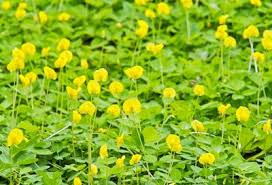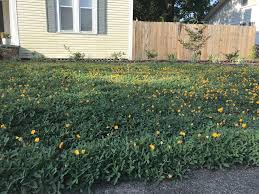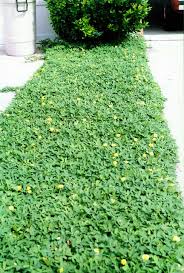Peanut Grass, also known by its scientific name Arachis pintoi, is a really cool plant that can do many good things for your yard. It’s like a magic carpet for your garden! This plant comes from South America, but it’s super good at growing in lots of different places and soils.
One amazing thing about Peanut Grass is that it’s like a superhero for your soil. It has a special power to make the soil better by putting important nutrients in it. These nutrients help other plants around Peanut Grass grow big and strong without needing any chemical stuff.
If you’re tired of fighting with pesky weeds in your yard, Peanut Grass can be your secret weapon. It grows close together and covers the ground so well that the weeds can’t find a place to grow. This means you don’t have to use yucky chemicals to keep the weeds away.
Taking care of Peanut Grass is easy-peasy. You don’t need to spend lots of time mowing it like a regular lawn. It’s like having a carpet of green that takes care of itself. Plus, Peanut Grass is a real friend to the environment. It helps save water because it doesn’t need much, and it gives a nice home to helpful bugs like butterflies and bees.
Imagine your yard covered in a soft, green carpet that helps the soil, keeps away weeds, and makes the world a better place for little bugs. That’s what Peanut Grass can do for you. So, if you want a garden that’s easy to take care of and looks great, Peanut Grass is the answer.
Read Also: A Guide to Growing and Caring for Poa Annua Grass
Growing and Care Guide of Peanut Grass

Peanut Grass, with its many benefits, is a fantastic addition to your garden or lawn. Here’s a simple guide to help you grow and care for Peanut Grass successfully:
1. Choosing the Right Location: Pick a sunny spot for your Peanut Grass. It loves sunlight, so make sure it gets at least 6 hours of direct sun each day.
2. Soil Preparation: Peanut Grass is quite forgiving when it comes to soil, but well-draining soil is best. If your soil is too compact, you can add some sand to improve drainage.
3. Planting: You can grow Peanut Grass from seeds or by planting runners (small plants). Plant them about 6-8 inches apart, so they have enough space to spread.
4. Watering: While Peanut Grass is drought-tolerant once established, it needs regular watering during its early stages. Keep the soil moist until the plants are established.
5. Fertilizing: One of the cool things about Peanut Grass is its ability to fix nitrogen in the soil. However, if you want to give it a boost, you can use a balanced fertilizer once or twice a year.
6. Weed Control: Peanut Grass forms a dense cover that helps keep weeds at bay. However, during the initial stages, keep an eye out for any unwanted plants and remove them promptly.
7. Mowing: You don’t need to mow Peanut Grass very often. Once it reaches a height of about 6-8 inches, you can give it a trim to encourage thick growth.
8. Pruning: Trimming the edges of your Peanut Grass patch can help keep it looking neat and tidy. Pruning also encourages lateral growth.
9. Winter Care: In colder climates, Peanut Grass might go dormant during the winter. Don’t worry; it will bounce back when the weather warms up.
10. Pests and Diseases: Peanut Grass is generally hardy and resistant to many pests and diseases. Just keep an eye out for any unusual changes in color or growth.
11. Propagation: If you want to expand your Peanut Grass area, you can easily propagate it by dividing established plants or planting runners.
12. Enjoy the Benefits: As your Peanut Grass grows, you’ll start to see its benefits. It’ll create a lush, green carpet, help the soil, and provide a welcoming habitat for helpful insects.
Remember, Peanut Grass is all about low maintenance and big rewards. With a little care and attention, you’ll have a beautiful and eco-friendly garden that you can enjoy year-round. Happy gardening.
Benefits and Uses of Peanut Grasses

Peanut Grass, scientifically known as Arachis pintoi, offers a range of benefits and versatile uses that make it a valuable addition to landscapes and gardens. Let’s explore some of the key advantages and practical applications of this remarkable plant:
1. Soil Improvement and Nitrogen Fixation: Peanut Grass is a nitrogen-fixing plant, which means it has a unique ability to take nitrogen from the air and put it into the soil. This enriches the soil with essential nutrients that support the growth of surrounding plants. By reducing the need for synthetic fertilizers, Peanut Grass contributes to healthier soil and more sustainable gardening practices.
2. Erosion Control and Soil Conservation: With its dense growth and deep-rooted nature, Peanut Grass acts as a natural shield against soil erosion. Its roots bind the soil particles together, preventing them from being washed away by heavy rain or wind. This makes Peanut Grass an effective erosion control method, especially on slopes and areas prone to soil loss.
3. Low-Maintenance Ground Cover: Peanut Grass forms a thick carpet-like cover that requires minimal maintenance. Unlike traditional lawns that demand frequent mowing, Peanut Grass grows at a moderate pace and maintains its neat appearance without constant trimming. This makes it an excellent choice for busy homeowners and those seeking a low-maintenance landscaping option.
4. Biodiversity and Habitat Support: Peanut Grass creates a welcoming habitat for beneficial insects, including pollinators like bees and butterflies. Its dense growth provides shelter and a safe space for these insects, promoting biodiversity in your garden. By supporting local ecosystems, Peanut Grass contributes to a healthier and more balanced environment.
5. Water Conservation and Drought Resistance: Adapted to varying climates, Peanut Grass exhibits impressive drought resistance once established. Its ability to conserve water within the soil reduces the need for frequent irrigation, making it an eco-friendly choice for regions with limited water resources.
6. Weed Suppression and Herbicide Reduction: The dense growth pattern of Peanut Grass naturally suppresses weed growth by shading out competing plants. This reduces the need for chemical herbicides and helps maintain a clean and weed-free garden without harming the environment.
7. Aesthetic Appeal and Landscape Design: Peanut Grass offers aesthetic versatility in landscaping design. It can be used to create neat borders, pathways, or even as a focal point in gardens. Its vibrant green color and uniform growth provide an attractive backdrop for other plants, enhancing the overall visual appeal of the landscape.
8. Livestock Forage and Animal Grazing: Peanut Grass has also been used as forage for livestock in some regions. It offers a nutritious food source for grazing animals, making it a valuable addition to pastures and animal grazing areas.
In addition, Peanut Grass is more than just a ground cover – it’s a multi-faceted plant with a host of benefits that contribute to sustainable gardening, soil health, and environmental well-being. Its ability to improve soil quality, control erosion, conserve water, and support local wildlife makes it a valuable asset for homeowners, landscapers, and anyone looking to create a greener and more vibrant outdoor space.
Read Also: A Guide to Growing and Caring for Karl Foerster Grass (Calamagrostis X Acutiflora)
Environmental Impact of Peanut Grasses

Peanut Grass, scientifically known as Arachis pintoi, has a positive environmental impact that extends beyond its aesthetic appeal. This versatile plant offers several benefits that contribute to a more sustainable and ecologically balanced ecosystem. Here are the environmental impact in more detail:
1. Water Conservation and Reduced Irrigation:
Peanut Grass is well-adapted to various climates and soil conditions, making it an excellent choice for water conservation. Once established, its deep roots help retain moisture in the soil, reducing the need for frequent watering. This conservation of water resources is crucial, especially in regions facing water scarcity and drought conditions.
2. Nitrogen Fixation and Reduced Fertilizer Use:
One of Peanut Grass’s remarkable qualities is its ability to fix nitrogen in the soil. This means it can pull nitrogen from the air and enrich the soil naturally. This process reduces the need for synthetic fertilizers, which often contribute to water pollution and soil degradation when overused.
3. Erosion Prevention and Soil Health: The dense growth and spreading nature of Peanut Grass create a protective barrier that helps prevent soil erosion. Its root system stabilizes the soil, reducing the loss of fertile topsoil due to wind or water. By maintaining soil health and structure, Peanut Grass contributes to long-term land sustainability.
4. Reduction in Chemical Inputs: Peanut Grass’s ability to suppress weed growth naturally reduces the need for chemical herbicides. This decreases the use of harmful chemicals in the environment, leading to improved soil quality and healthier ecosystems.
5. Habitat Support for Pollinators and Wildlife: The lush and dense growth of Peanut Grass provides habitat and food sources for various pollinators, insects, and small animals. By creating a favorable environment for these creatures, Peanut Grass contributes to the overall biodiversity of the area and supports a thriving ecosystem.
6. Carbon Sequestration and Air Quality Improvement: Like other plants, Peanut Grass absorbs carbon dioxide (CO2) from the atmosphere during photosynthesis. By sequestering carbon, it plays a role in mitigating the effects of climate change. Additionally, its presence contributes to improved air quality by releasing oxygen through photosynthesis.
7. Reduction of Heat Island Effect: Urban areas often experience the “heat island” effect, where temperatures rise due to human activities and lack of vegetation. By incorporating Peanut Grass into urban landscapes, the heat island effect can be mitigated as it provides a cooler and more pleasant microclimate.
8. Low Maintenance and Resource Efficiency: Peanut Grass’s low-maintenance requirements translate to fewer resources being expended on mowing, watering, and chemical treatments. This leads to reduced energy consumption and overall resource use, contributing to a more environmentally friendly landscape management approach.
In conclusion, Peanut Grass’s environmental impact goes beyond its surface beauty. Its ability to conserve water, enhance soil quality, support wildlife, reduce chemical inputs, and contribute to a healthier ecosystem makes it a valuable asset for sustainable landscaping and a greener future. Whether in residential yards, public spaces, or commercial areas, the presence of Peanut Grass can have a positive ripple effect on the environment.
Read Also: Hazardous Waste Disposal Equipment: What You Need to Know
